by Ben Young Landis
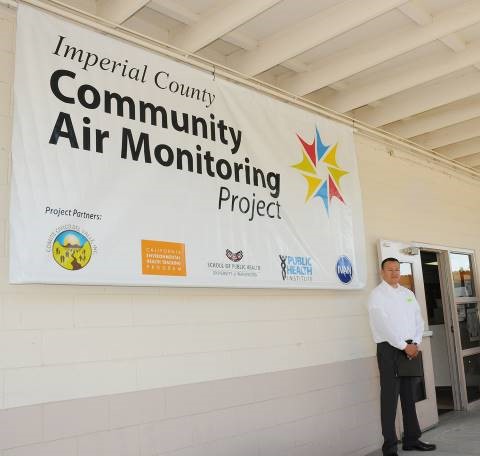
Luis Olmedo is the executive director of Comité Civico Del Valle, a community advocacy group serving Imperial County, California. Image courtesy of Michelle Wong.
Imperial County is tucked away in the southeastern corner of California. It is a dry, desert landscape, dotted with small towns and dominated by the agricultural industry. The nearest major city, Mexicali, is not even part of the United States, but lies across the Mexican border.
This rural expanse is where Luis Olmedo calls home.
“You can drive in any direction during a lunch break, and in no time you’ll be in the middle of nowhere, either in the desert or surrounded by ag land,” says Olmedo, who is the executive director of Comité Civico Del Valle, a community advocacy group. “At night, you can still see the stars!”
But this pastoral setting belies its persistent air quality issues. Tight-knit, family-oriented, and predominantly of Mexican descent, these communities are at risk for asthma and other health problems, related to particulate matter levels heightened by human activities and environmental conditions. Worse, local residents had been relatively unaware of these pollutant impacts, having poor access to environmental information and little dialog with government regulators.
Addressing this burgeoning environmental justice scenario is the Imperial County Community Air Monitoring Project, a fascinating partnership uniting a nongovernment organization, state agency scientists, university professors, and community leaders. Together, they are embedding low-cost air monitoring technology throughout neighborhoods, guided and assisted by the residents of those very neighborhoods, and developing an interactive GIS map to translate air quality data into actionable alerts easily understood by families, schools, and local leaders.
Talking with the project team, however, it becomes clear that the breakthrough innovation here is neither hardware nor software: it is the researcher-community partnership itself — and the collaborative process they have created to ensure mutual communication and participation at every step.
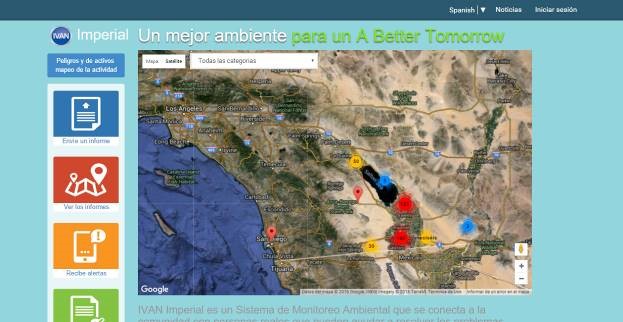
A screenshot of the Spanish-language version of the IVAN-Imperial (Identifying Violations Affecting Neighborhoods) website, which displays community-crowdsourced reports on environmental hazards. Image courtesy of Comité Civico Del Valle.
Initially, IVAN
The project, funded by the National Institute of Environmental Health Sciences, brings together several key players among a broad field of collaborators. Paul English, a California Department of Public Health epidemiologist, serves as lead investigator. Michelle Wong of the nongovernmental Public Health Institute and the California Environmental Health Tracking Program functions as the project’s community engagement coordinator. Edmund Seto, an environmental health professor with the University of Washington School of Public Health, weighs in as technical advisor.
But it is the residents of Imperial County who drive the project direction and actions, as assisted by Comité Civico, which has been an organizing voice for locals since its early days championing education access for migrant children. “A lot of times, we refer to scientists and government officials as ‘experts’ on a subject,” says Olmedo. “But when it comes to environmental justice, the community is the first to see something. They live here 24/7, around the clock.”
The community first realized asthma was a growing issue in the 1990s, but didn’t know the causes. “We live with agricultural burns, diesel fumes, and all kinds of emissions here, but we never made the connection to health,” says Olmedo. “Growing up here, it’s just a part of life, but you never realize all these emissions around you come with a consequence.”
As legal debates over Imperial County air quality played out in the 2000s, Comité Civico shifted its focus to public health issues. Olmedo remembers going on an environmental justice tour elsewhere in California to learn about circumstances in other communities, but leaving with the awkward feeling that it was “more like a safari” that offered little benefit for the places they visited.
In 2007 and 2008, it was Olmedo’s turn to lead his own environmental justice tours — on home turf in Imperial County for the California Department of Toxic Substances Control (DTSC) — and he made sure the visitors left more than just footsteps. Olmedo found an ally in Ryan Atencio, a DTSC inspector at the time, who began working with Comité Civico on ways for the community to gather evidence of pollution violations, which DTSC could then address or delegate to other authorities.
The result was “IVAN” — Identifying Violations Affecting Neighborhoods — a central database that lets the public directly report incidents of potential environmental impact. Observations of illegal dumping, unauthorized fires, and other events can be submitted via mobile phone or computer, along with location data, photos, and videos.
The resulting map is a sobering representation of possible sources of human health stressors in the region — and gives local leaders a transparent tool to communicate with regulators and residents for further action. Given its simplicity and convenience, the IVAN platform has since been expanded to enhance environmental justice reporting in six other regions around California.
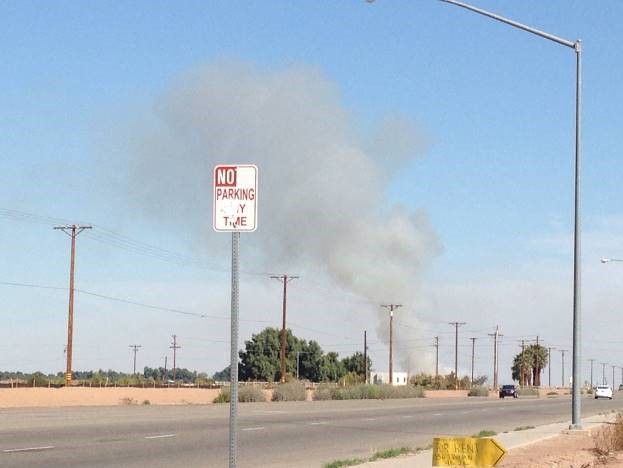
Agricultural burns like this one contribute to asthma and other health conditions in residents of Imperial County, California. Image courtesy of Michelle Wong.
Pues, Promotoras
Besides air quality, Imperial County has been dealing with another public health issue: perchlorate-contaminated water and soil stemming from a former chemical factory upstream on the Colorado River. In high doses, perchlorate can impair thyroid function and affect physical development in children and fetuses.
Public health researchers including English and Wong wanted to gather data on perchlorate exposure levels in Imperial County to assess whether residents were in danger. “There hadn’t been much attention to environmental health issues down in Imperial County,” says English. “It’s a really neglected area.”
Hearing that the researchers were looking for a way to collect physical samples from residents, Comité Civico recommended that the researchers collaborate with the existing network of local “promotoras” — local, Spanish-speaking individuals who serve as trusted resources for health information. The promotoras recruited volunteers to contribute urine, drinking water, and produce samples for perchlorate testing.
Later, the results were communicated back to the community and published in a scientific paper — with Luis Olmedo listed as a coauthor. The successful collaboration helped build the foundation for what would become an ambitious air-quality monitoring project in Imperial County.
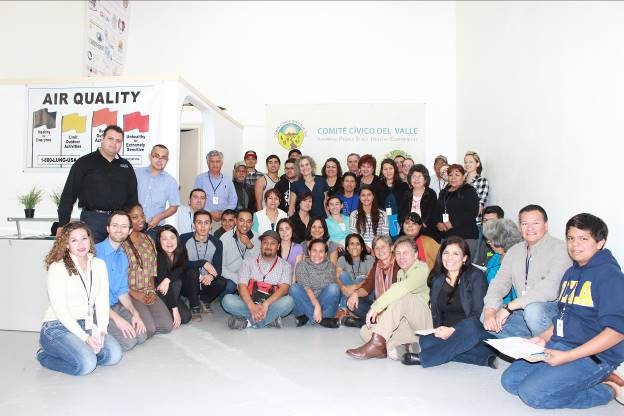
The Imperial County Community Air Monitoring Project works closely with its Community Steering Committee and other community participants, which lets residents communicate directly with project scientists and facilitators. Image courtesy of Michelle Wong.
Air Quality Monitoring by—and for—the People
When he first moved to Imperial County from Mexicali, Olmedo merely wanted to live the American dream. Working in retail and in bookkeeping, he thought about getting that nice car, those nice suits, and wealth for the family. He was always shy about public speaking.
“Being from a rural community, I never had to stand in front of a conference, and speak to a room with hundreds of researchers,” he says.
As Comité Civico’s executive director, Olmedo now travels regularly across California and the United States to speak up for Imperial County. His role and perspectives for the welfare of his community have grown.
“You have to understand that on my outings to Sacramento or to Washington back then, a lot of times they’ll have just one person covering the entirety of southern California,” Olmedo says. “I never really got the opportunity to sit down with someone and actually discuss ‘so what do we do now?’ These conversations didn’t happen. Even with larger nonprofit organizations, they would come in and speak for the community, but we didn’t have a seat at the table.”
With the Imperial County Community Air Monitoring Project, things would be different.
“When the opportunity came to apply for this funding, it was a no-brainer,” says Michelle Wong, the project’s community engagement coordinator. “Air quality was a huge concern for this community, and asthma was a big problem. There was a lot of interest among the residents about health and the environment, and on this project, they would actually have a say.”
All of the pieces that had been evolving over the years — the maturation of Comité Civico; a trusted working relationship among Olmedo, English, Wong, and others; the development of the IVAN hazards map — began to fit together.
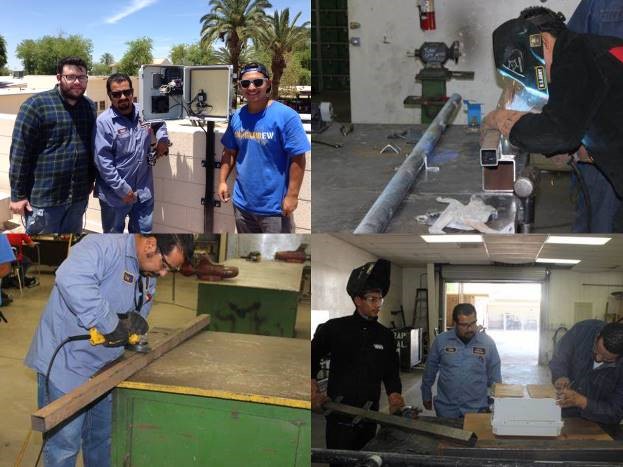
The Imperial County Community Air Monitoring Project involved many members of the community, including the local high school’s metal shop, which designed and built the mounting stands for the air quality monitoring stations. Image courtesy of Michelle Wong.
The proposal was to set up 40 sensors for community air quality monitoring around Imperial County, then translating the data through the IVAN platform. The new network would give residents near real-time access to information with which to understand and limit their exposure to poor environmental conditions — the kind of detailed, localized information no one else was providing them.
“Our sensors are not designed to take the place of existing regulatory monitors. Those are meant to check against federal and state air quality standards, to measure background levels of pollution,” notes English. “Our monitors are attempting to measure neighborhood levels and are closer to local sources of pollution and where people live. It’s for the people.”
To guide the project, the team established several advisory bodies to represent the community’s needs.
“We have a community steering committee of about 15 residents, including parents, youth, and teachers, and they actually provide guidance into all project activities,” says Wong. “We also recruited about 30 residents in 11 vulnerable communities to do data collection and provide recommendations to help identify locations for siting our sensors.”
The benefits of the collaboration were evident from the very first sensor installation, at Brawley Union High School. During setup, the research team realized they needed a better way to secure the equipment. “There was a metal shop at the high school, and the students were able to design these custom metal monitor stands on the spot,” says Wong. “It was totally unexpected, and it saved everyone hours of figuring out how to do it. It was also a great experience and a great feedback loop for the students to know that they contributed something important to their own school.”
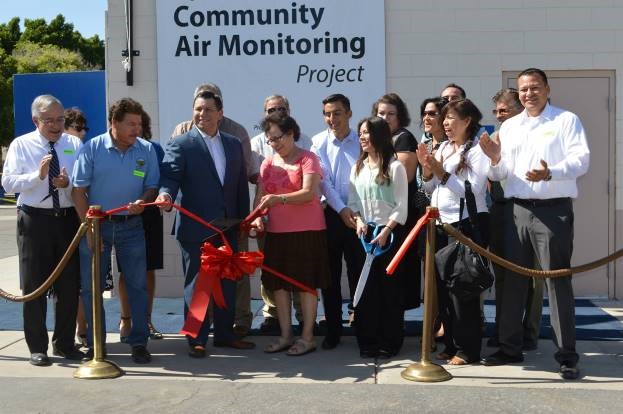
The ribbon-cutting ceremony dedicating the Imperial County Community Air Monitoring Project at Brawley Union High School in Brawley, California. Image courtesy of Comité Civico Del Valle.
Partnerships a Decade in the Making
The project has been as much a learning experience for the academic researchers and public health professionals as for the community — perhaps more so. Edmund Seto, a professor of environmental health and technical advisor for the project, marvels at seeing firsthand the benefits of such a close community engagement.
“I would never have imagined on the outset that this could be such an interactive process,” says Seto. “Generally in academic research, we get the data, we do the analysis, and we do a paper. This is different. We don’t do anything until we get buy-in from the community, and we have regular meetings and call-backs with residents.”
For Seto, a key focus is translating the monitoring data into formats actually useful for everyday people. “It’s not really helpful to just do academic research and drop a report on the community and expect them to know what to do with it,” he says. “What is an asthmatic going to do with the information? What’s the most useful way to apply the data to benefit the typical Imperial County resident?”
Michelle Wong agrees, and champions their use of a “multi-tiered participatory model” to cross-link local knowledge with academic knowledge. “As someone coming from a non-scientific background, I wanted to make sure that scientists understand the community, and the community understands the scientists, so that everyone can communicate and work together in a meaningful way,” she says.
Wong and English say that successful partnerships linking government, nonprofit, and community participants are rather unique, but the Imperial County Community Air Monitoring Project has demonstrated how much could be accomplished under such partnerships. They are already getting inquiries about how to adapt this experience to other communities in California.
Then again, not every community has a resource like Comité Civico already embedded. But that, Luis Olmedo says, is a credit to the time and people who preceded him.
“We’re really proud of this program, but it’s not something where we woke up one morning, and funding was there,” Olmedo emphasizes. “We’ve been building these partnerships for more than a decade, progressed over all these years, so we could have this monitoring and finally be able to do something about our community’s health.”
Olmedo is also seeing how citizen science opportunities are generating enthusiasm among families and students, and all the possibilities it opens up for understanding the future of Imperial County in terms of public health, climate change, and other issues.
“It democratizes environmental monitoring,” says Olmedo. “I really see it as the future — cost-efficient and rapid response for environmental justice communities. People are going to depend on this.”
Ben Young Landis is a freelance science communicator and a contributing writer for Creative Science Writing and the Thriving Earth Exchange.
